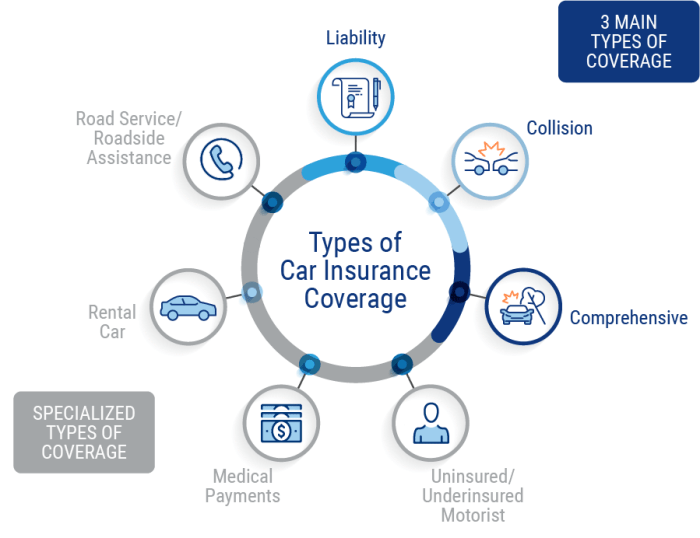The world of auto insurance can feel like a labyrinth of jargon and fine print. Understanding the different types of auto insurance plans available is crucial for protecting yourself financially and legally. This guide unravels the complexities, offering a clear and concise explanation of various coverage options, factors influencing premiums, and the process of choosing the right plan for your individual needs. We’ll explore everything from liability and collision coverage to the importance of understanding your policy documents and navigating the claims process.
From comparing different providers and their offerings to understanding legal requirements and dispelling common misconceptions, we aim to empower you with the knowledge necessary to make informed decisions about your auto insurance. This guide provides a practical, step-by-step approach to help you confidently navigate the complexities of auto insurance and secure the best possible coverage for your circumstances.
Common Misconceptions about Auto Insurance

Understanding your auto insurance policy is crucial for financial protection in the event of an accident or damage to your vehicle. Many people hold misconceptions about what their coverage includes and how it works, leading to potential financial hardship. Clarifying these common misunderstandings can help you make informed decisions and ensure you have the right level of protection.
Comprehensive Coverage Covers Everything
Many believe that comprehensive coverage protects against all possible scenarios. This is incorrect. While comprehensive coverage does indeed cover a wide range of events, such as theft, vandalism, and damage from natural disasters, it typically excludes damage caused by collisions. Collision coverage is a separate policy that addresses damage resulting from accidents with other vehicles or objects. For example, if a tree falls on your car, comprehensive coverage would apply. However, if you hit another car, collision coverage would be needed to repair your vehicle. Failing to understand this distinction can leave you with significant out-of-pocket expenses after an accident.
Higher Deductibles Always Mean Lower Premiums
It’s true that choosing a higher deductible generally results in lower premiums. However, it’s essential to consider your financial situation before opting for a significantly higher deductible. A higher deductible means you’ll pay more out-of-pocket in the event of a claim. If you’re facing financial constraints, a higher deductible, while saving on premiums, might create an insurmountable burden should you need to file a claim. Carefully weigh the balance between premium savings and your ability to afford a higher deductible in case of an accident.
Your Car’s Value Dictates Your Coverage
The value of your vehicle does influence your insurance premiums, but it doesn’t directly determine the amount of coverage you receive. You need to choose coverage limits that adequately protect your financial interests, regardless of your car’s worth. For example, if you have an older car with a low market value, you might think minimal liability coverage is sufficient. However, if you cause an accident resulting in significant injuries or property damage, your liability could far exceed your car’s value, leaving you personally responsible for the difference. Adequate liability coverage protects you from potentially devastating financial consequences.
Understanding your auto insurance policy is not just about finding the cheapest option; it’s about securing the right level of protection for your specific needs and financial circumstances. Reviewing your policy regularly and asking questions to your insurer is vital to ensure you are adequately covered.
Last Point

Securing adequate auto insurance is not merely a financial transaction; it’s a critical component of responsible driving and personal safety. By understanding the various plan types, factors influencing premiums, and the intricacies of policy documents, you can confidently choose a plan that aligns with your needs and budget. Remember, proactive planning and a thorough understanding of your coverage can significantly mitigate financial risks associated with accidents and unforeseen circumstances. This guide serves as a starting point for your journey towards informed decision-making in the realm of auto insurance.
Query Resolution
What is the difference between liability and collision coverage?
Liability coverage pays for damages you cause to others, while collision coverage pays for repairs to your vehicle regardless of fault.
How often can I expect my insurance rates to change?
Rates can change annually, or even more frequently, based on factors like driving record, claims history, and changes in your personal information.
What happens if I’m in an accident and don’t have insurance?
Driving without insurance is illegal and can result in significant fines, license suspension, and even jail time. You’ll also be responsible for all accident-related costs yourself.
Can I bundle my auto and homeowners insurance?
Yes, many insurance companies offer discounts for bundling auto and homeowners (or renters) insurance policies.
What documents do I need to file a claim?
Typically, you’ll need police reports, photos of the damage, and contact information for all involved parties.